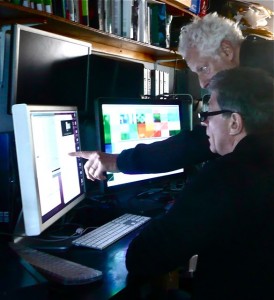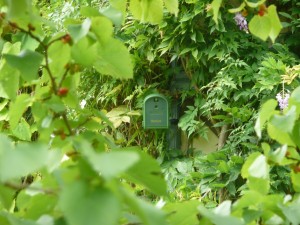
Sunbeam Project Team: (L to R) Robert Walsh. Stephane Regnier, Chris Meigh-Andrews, David Henckel.
J M W Turner’s last words are supposedly ‘the sun is God’ (though this is more than likely an invention of John Ruskin’s). Whatever the actual truth of the situation Turner’s final pronouncement seems both archaic, in that it harks back to earlier periods of actual sun worship, and curiously modern, not least because it anticipates Georges Bataille’s notion of ‘expenditure’. In The Accursed Share, his book about this idea, Bataille proclaims that ‘[S]olar energy is the source of life’s exuberant development. The origin and essence of our wealth are given in the radiation of the sun, which dispenses energy – wealth – without any return. The sun gives without ever receiving’ (Bataille, 1991, 28). Thus, for Bataille, the sun is exemplary of the principle of a ‘general economy’ which escapes the restriction of the economy in the more accepted sense, a system that involves reciprocity and exchange. As such it is like poetry and art, which, as Jacques Derrida points out, writing about Kant’s Third Critique, must remain a form of production that ‘must not enter into the economic circle of commerce’ (Derrida, 1981, 5). Derrida explicitly describes the status of art in solar terms, invoking in particular the ‘God, King, Sun, Poet, Genius, etc. give of themselves without counting’, as examples of the ‘generous overabundance of a solar source’ (ibid, 12). Here perhaps is another reason for Turner’s fascination with the sun, not just as a source of extraordinary light and colour effects, but also as a figure for art itself, an activity of prodigious expenditure beyond what might be needed for effective economic exchange.
In the light of diminishing non-renewal resources solar energy’s own prodigious expenditure is becoming increasingly interesting as a source of renewable energy. The question is always how to capture as much of this energy as it pours down onto our planet and dissipates. Solar panel technology is becoming ever more sophisticated in response to this challenge. ‘Solar trackers’ are a recent highly effective development in this field, being large photovoltaic panels mounted on pivots that allow them to move in relation to the sun, and thus to minimise the angle of incidence between the panel and sun. This greatly increases their efficiency. It also, deliberately or otherwise, makes them resemble the most solar of all flowers, the aptly named sunflower, which not only resembles the sun, but is also, like the solar trackers, ‘heliotropic’ (from ‘helios’, sun, and ‘tropos’, move). (This is perhaps why Vincent van Gogh was so drawn to sunflowers, and painted them so many times. He too was drawn to the sun, as his move south to Provence demonstrated. Such a fascination was more than merely aesthetic, but also religious. For van Gogh the sun stands for God as Christ and the sunflower as the pious soul.)
The University of Central Lancashire (UCLAN) has recently installed a set of solar trackers. The website announcing this installation studiously avoids poetic language and sticks to a highly prosaic description of the benefit they will bring: ‘The trackers are 40% more efficient than standard solar panels and can gather electricity even when it’s cloudy. The trackers, which will save 6,134 kgs of CO2 per year, are being installed by Energy Holdings ltd and were part-funded by the Bre LCBP Phase 2 grant scheme. The electricity generated will feed the national grid.’
Looking beyond this apparently mundane set of purposes Chris Meigh-Andrews, professor of Electronic and Digital Art at UCLAN has been inspired to use the solar trackers in an artistic project that reveals the solar trackers’ innate poetry. Sunbeam is the latest in a number of projects by Meigh Andrews, made over many years, which involve the use of renewable energy technology as both subject and power source. For example Perpetual Motion from 1994, Fire, Ice and Steam, from 1995, Mothlight in 1998, and Resurrection from 2005/6. Mothlight, in which screens showing the fluttering of a moth were powered by solar panels, engaged with the sun as a power source, though it did involve a ‘cheat’ in that the panels were energised not by sunlight but by powerful lights plugged into the mains. Thus Mothlight was more effective at representing than actually enacting the idea of an artwork powered by renewable resources. Interwoven Motion, commissioned by the Foundation for Art and Creative Technology (FACT) in Liverpool in 2004, has probably come the closest up till now to realising his ambitions to make a work of art powered by a renewable energy source. In this work, sited in Grizedale Forest in the Lake District Meigh-Andrews mounted a number of solar panels and a wind turbine on a tree overlooking the lake. These in turn supplied the power for four cameras mounted high up in the tree which in turn relayed images to a video screen at the base.
Meigh-Andrews also produced another work involving solar energy; For William Henry Fox Talbot (The Pencil of Nature) from 2002 was commissioned by the V&A for the exhibition “Digital Responses”. It involved a live solar-powered web cam projection in real time between Lacock Abbey (the family home of photography pioneer Fox Talbot) in Wiltshire and the Victoria and Albert in London. As Vince Dziekan describes the work in his essay ‘Distributed Aesthetics and the Tele-image’: ‘Besides connecting two geographically separate sites, the work staged through its uninterrupted image-flow – the connection that history maintains with the present, and reconnected photography to its origin as (sun) light (evoking Joseph Nicephore Niepce’s earlier assignment of the term, heliography)’ (Dziekan, 2006).
In Sunbeam Meigh-Andrews now perhaps realises what the earlier works hinted at, an artwork which both represents the prodigious energy of the sun and performs its effects by using that energy to make the representation possible. Produced in collaboration with astrophysicist Dr Robert Walsh of the Jeremiah Horrocks Institute for Astrophysics and Supercomputing at UCLAN, with assistance from Dr. Stephane Regnier and David Henckel Sunbeam is a ‘temporary outdoor event’ involving the projection of ‘animated image sequences produced from high definition images of the sun taken by NASA’s Solar Dynamics Observatory (SDO) onto the large solar tracker array at the University of Central Lancashire’. That the energy harvested during the day can then be used to make an artwork possible beautifully encapsulates Bataille’s notion of art as a form of general economy exemplified in the sun itself. The system that harnesses the sun’s extraordinary power for straightforward and restricted uses, such as supplying energy to the university and to the national grid, is ‘detourned’ to produce a work of art, or in other words something useless according to the restricted economy of reciprocity and exchange. This is, perhaps, the very definition of art itself.
Charlie Gere, Lancaster, April 2011.
Works Cited:
G. Bataille (1991), The Accursed Share, vol. 1 (New York: Zone Books)
J. Derrida (1981), ‘Economimesis’, Diacritics, Vol. 11, No. 2 (Summer, 1981), pp. 2-25
V. Dziekan (2006), ‘Distributed Aesthetics and the Tele-image’, http://www.acuads.com.au/conf2006/papers_refereed/dziekan.pdf, accessed 28th April, 2011
Dr Charlie Gere is Reader in New Media Research at the Lancaster Institute for the Contemporary Arts, Lancaster University.









